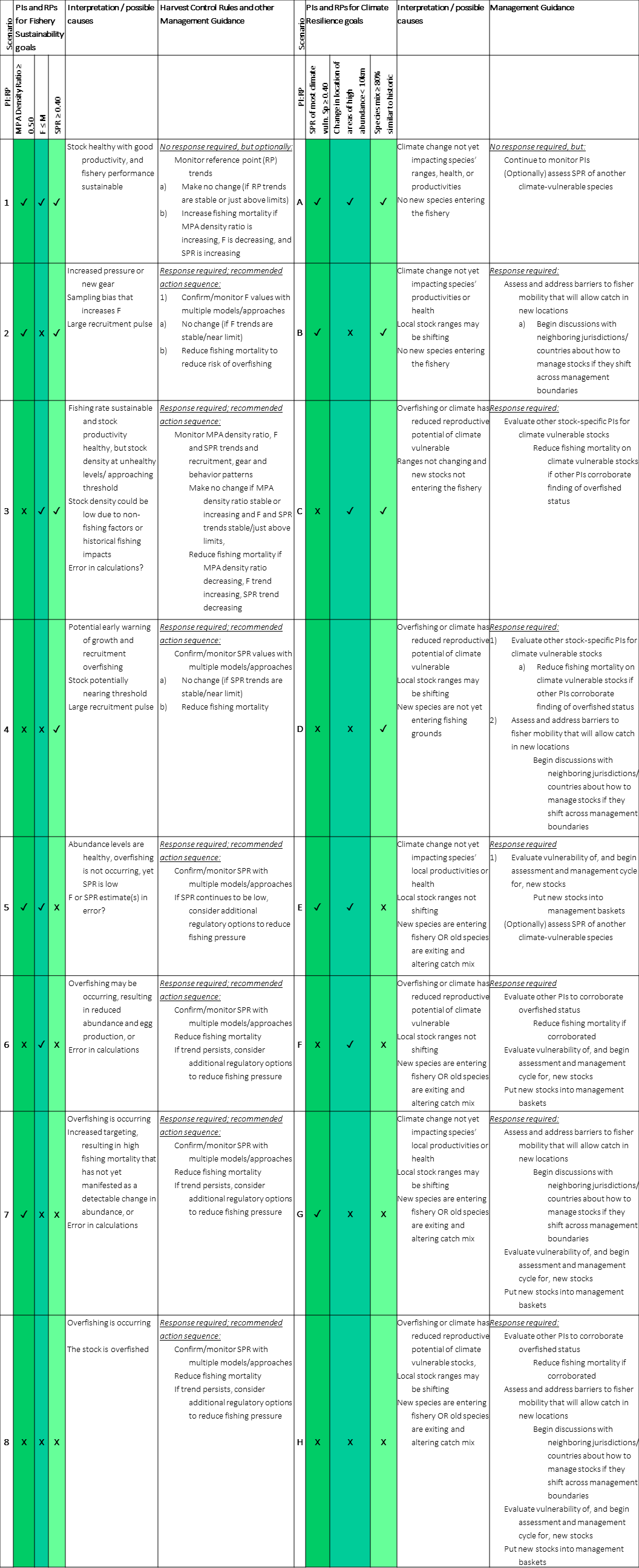To make science-based fishery management decisions, we need Harvest Control Rules (HCRs), which are simply rules that tell managers what to do when performance indicators are found to be meeting or not meeting their targets, near their limits, or past their limits. In other words, we select PIs and RPs that can tell us whether or not we are on track to meeting our fishery management goals, and then we develop HCRs to tell us what to do when we get the answer to that question. These rules would apply to target stocks in single species fisheries, and to the representative species of management baskets in multispecies fisheries.
HCRs are not the same as “harvest control measures” or “fishery regulations,” which dictate specific ways to control fishing mortality or fishing effort, such as with catch limits, size limits, or seasonal restrictions. Instead, HCRs are simple rules that say “if we find that our fishery is in X condition, we will do Y.” For example, an HCR might specify that if assessments reveal that the PIs selected to tell you if your fishery is operating at sustainable levels are all exceeding their limit RPs or falling short of their target RPs (indicating that the fishery is over-exploited, and/ or that the fishery is unsustainable), fishing mortality will be reduced in an effort to restore depleted stocks. The HCR does not say how you will reduce fishing mortality. It does not say (for example) “we will reduce fishing mortality by reducing quotas,” or “by closing spawning grounds to fishing,” or “by changing gears,” or “by closing the fishery.” Each of these is an example of a specific management measure that stakeholders might select to achieve the change indicated by the HRC. We will discuss the selection of management measures, based on interpretation of the results of our assessments that let us compare our performance indicators to our reference points, in later steps (Steps 10 and 11).
It is important for an inclusive group of stakeholders and managers to develop and agree on their suite of HCRs in a safe and neutral setting before any management decisions need to be made (i.e., before the assessments of PI relationships to RPs have been done). This can help improve compliance by ensuring management responses are objective, consistent, transparent, and appropriate, and also by increasing stakeholder buy-in to decisions. Therefore, it is important to identify all foreseeable possible scenarios that could occur in the fishery and create corresponding HCRs for each scenario (see the table below). By agreeing on HCRs and other general management guidance in advance of doing any assessments, you can also reduce the temptation to make up rules that allow people to keep fishing at the same level, regardless of what the PI levels are relative to their RPs.
Harvest Control Rules should be developed for each possible scenario of performance indicator levels in relation to reference points. See the Guidance Document for choosing PIs, identifying RPs, and defining HCRs in the downloadable Workbook for step-by-step guidance on defining appropriate HCRs for your fishery. See Step 10 for guidance on interpretation.
Here are some example Harvest Control Rules (HCRs) and management guidance for three Performance Indicators (PIs) that stakeholders may develop when considering Performance Indicators (PIs) and Reference Points (RPs) related to their fishery sustainability and climate resilience goals. HCRs associated with the fishery sustainability goals and performance indicators might point to the need for further stock assessments, or they might suggest precautionary management measures that could be implemented immediately while additional information is being gathered. Management guidance associated with climate resilience goals and performance indicators are likely to point to actions that stakeholders might need to take in the event of systemic changes, such as those that might be driven by climate change. This guidance may be less well-defined than the HCRs in the left half of the table, but the participatory process is still valuable to begin to develop a plan and create take the necessary steps to move towards any necessary system transformation.
Note that the PIs and RPs presented in the table below are presented as examples only, and the appropriate PIs and RPs for your fishery will depend on stakeholders’ goals, the data available, and the level of risk that stakeholders are willing to tolerate. For example, in the table we present the climate-relevant PI “Change in location of areas of high abundance,” with the corresponding target RP of “< 10km.” To be more precautionary (i.e., to reduce risk), stakeholders could instead choose to track the change in the poleward edge of the stock distribution, however this metric would probably be somewhat more difficult to track. Similarly, reducing the amount of movement that can be observed before a management action is triggered, e.g., changing the RP to (for example) < 5km, would also be a somewhat more precautionary approach.
Step 8, Table 1: Example Harvest Control Rules for Three PI/RP combinations for Fishery Sustainability and Climate Resilience Goals




